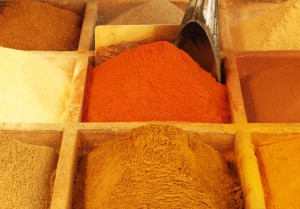 g people how to flavour food with spices and herbs was “considerably more effective” at lowering salt intake than having them reduce their salt intake on their own, according to research from the University of California.
g people how to flavour food with spices and herbs was “considerably more effective” at lowering salt intake than having them reduce their salt intake on their own, according to research from the University of California.The study, which was presented in March 2014 at the American Heart Association’s Epidemiology and Prevention/Nutrition, Physical Activity and Metabolism Scientific Sessions 2014, used a group of 55 volunteers and was completed in two stages. More than 60 per cent of the participants in the study had high blood pressure, 18 per cent had diabetes and they were overweight.
Study method
In the first phase of the study, the 55 volunteers ate a low-sodium diet for four weeks. Researchers provided all foods and calorie-containing drinks.
In the second phase, half of the study volunteers participated in a 20-week intervention aimed at reducing their sodium intake to 1,500 mg/day by using herbs and spices. The other half reduced sodium on their own.
Those assigned to the behavioural intervention group had cooking demonstrations and had a chance to share how they were changing traditional recipes to remove salt and include spices. The researchers did not emphasise specific spices, and encourage participants to try different things to find out what they liked most.
Learning how to use herbs and spices helped
The researchers found that in first phase of the study, sodium intake decreased from an average 3,450 mg/day to an average of 1,656 mg/day. In the second phase, sodium intake increased in both groups.
However, those who received the behavioural intervention consumed an average of 966 mg/day of sodium less than the group that did not received the intervention.
“People in the intervention group learned problem-solving strategies, use of herbs and spices in recipes, how culture influences spice choices, how to monitor diet, overcoming the barriers to making dietary changes, how to choose and order foods when eating out, and how to make low-sodium intake permanent,” said Cheryl A.M. Anderson, PhD, MPH, lead author of the study and Associate Professor in the Department of Family and Preventative Medicine at the University of California San Diego.
“Salt is abundant in the food supply and the average sodium level for Americans is very high — much higher than what is recommended for healthy living,” Dr Anderson said. “We studied the use of a behavioural intervention where people learn how to use spices and herbs and less salt in their daily lives,” she said.
“Given the challenges of lowering salt in the American diet, we need a public health approach aimed at making it possible for consumers to adhere to an eating pattern with less salt,” Dr Anderson said. “This intervention using education and tasty alternatives to sodium could be one solution,” she said.
Co-authors on the research were Laura K. Cobb, MS; Edgar R. Miller, MD, PhD; Mark Woodward, PhD; Alex Chang, MD, MS; Morgana Mongraw-Chaffin, PhD; and Lawrence J. Appel, MD, MPH. The McCormack Science Institute funded the study.





